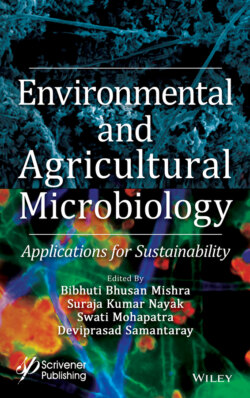Читать книгу Environmental and Agricultural Microbiology - Группа авторов - Страница 21
1.5 Molecular Aspects of Pesticide Biodegradation by Microalgae
ОглавлениеSeveral scientific studies are available in which algae and cyanobacteria have been reported to be highly efficient in detoxification of xenobiotics such as pesticides. Singh et al. [41] reported the degradation of the organophosphorus insecticide chlorpyrifos by the cyanobacterium Synechocystis PUPCCC. According to the author, the degradation mechanism of chlorpyrifos by cyanobacteria might be similar to bacteria. In bacteria, phosphotriesterases are the major group of enzymes involved in degradation of organophosphate pesticides [50]. These enzymes are encoded by a gene called opd (organophosphate-degrading). Mulbry and Karns [51] cloned and sequenced the gene. Phosphotriesterases are responsible for hydrolysis of phosphoester bonds, such as P–O, P–F, P–NC, and P–S [52]. The opd gene encoding organophosphorus hydrolase (the enzyme responsible for degradation of organophosphate pesticide) has 996 nucleotides, a typical promoter sequence of the promoter TTGCAA N17 TATACT from E. coli [53]. Chungjatupornchai and Fa-Aroonsawat [54] expressed opd gene from Flavobacterium sp. both on the surface and intracellularly in the cyanobacterium Synechococcus PCC7942 and used it for biodegradation of organophosphate pesticide. This reflects the importance of opd gene in biodegradation of organophosphate pesticides.
Exposure of plants to toxic organic substances provokes production of intracellular reactive oxygen species (ROS) which may adversely affect various cellular functions such as peroxidation of lipids and oxidation of proteins [55]. In order to minimize the adverse effects of ROS, plants possess an elaborate defense system consisting of antioxidant enzymes. Scavenging of ROS depends on the coordinated function of antioxidant enzymes such as Superoxide dismutase (SOD), Catalase (CAT), and Ascorbate peroxidise (APX) [56]. SOD is involved in the dismutation of superoxide anion O2− to H2O2 and O2. H2O2 is further scavenged by the catalytic activity of CAT and APX. APX is involved in the ascorbate-glutathione cycle to reduce stress [55, 57]. Jin et al. [43] reported an upregulation of the genes encoding Mn-SOD, CAT, and APX in green alga C. reinhardtii exposed to the herbicide prometryne. An efficient scavenging/detoxification system is responsible for quick accumulation and degradation of pesticide by microalgae [40]. Jin et al. [43] also noted an upregulation of the inducible gene HO-1 (Heme Oxygenase-1) in C. reinhardtii exposed to the herbicide prometryne suggesting its involvement in the tolerance of the microalgae toward the herbicide. Kumari et al. [58] evaluated butachlor toxicity in Aulosira fertilissima using a proteomic approach. They concluded that out of eight proteins altered during butachlor exposure, downregulation of GroES (associated with protein folding), and overexpression of NusB (associated with transcription termination) are curtail for cell death. Molecular docking studies confirm that interaction of butachlor with GroES and NusB is responsible for its toxicity [59].
Agrawal et al. [60] demonstrated the molecular basis of butachlor toxicity/tolerance in three Anabaena species using comparative proteomics. The study showed that 75 proteins involved in photosynthesis, C, N and protein metabolism, redox homeostasis, and signal transduction were differentially expressed in each Anabaena sp. Agrawal et al. [61] reported that a novel aldo-keto reductase (AKR17A1) from Anabaena sp.7120 has the capacity to degrade chloroacetanilide herbicide butachlor. The study demonstrated that, in addition to combating multiple stresses, aldo-keto reductase encoding open reading frame all 2,316 plays a significant role in butachlor degradation. The gene can be used to develop transgenics with butachlor degradation and stress tolerance capabilities [61].
For evaluation of biodegradation and biotransformation of pesticide by microalgae, time-dependent environmental risk assessment is very essential [62]. Esperanza et al. [63] evaluated the toxicity of the widespread herbicide atrazine to the green alga C. reinhardtii by the transcriptomic and proteomic approach. They found that exposure of the microalgae to sublethal concentration of atrazine (0.25 μM) for 3 h resulted in differential expression of 185 genes, of this 124 showed upregulation and 61 genes showed downregulation. These genes belonged to 13 different categories of function such as photosynthesis, metabolism, gene expression, energy, amino acids, cell cycle, redox, lipid, regulation, ROS and stress, proteases, other and unknown [64]. They also noted that nine genes related to photosynthesis were differentially expressed, of which three genes (HLA3, LCIA, and ELI3) showed significant upregulation and six genes (LHCBM8, LHCSR3, LI818R-1, PTOX2, CAH4, and CAH5) showed significant downregulation. In a recent study Tiwari et al. [65] demonstrated the tolerance strategy of cyanobacteria Fischerella sp. exposed to organophosphorus insecticide MP by analyses of proteome and transcriptome. Proteome analysis revealed a differential expression of proteins connected to various metabolic activities such as photosynthesis, energy and protein metabolism, redox homeostasis, signal transduction, and cellular defense. Transcript analyses showed differential expression of genes such as phycocyanin α subunit (cpcA), ribulose bisphosphate carboxylase (rbcl), F0F1 ATP synthase subunit α, F0F1 ATP synthase subunit β, SOD (sod), NifH (nif H), DnaK (dnaK), and Peptidase S8 in Fischerella sp. exposed to MP. In addition, some hypothetical proteins related to signaling and carbohydrate metabolism were also found to be upregulated in the cyanobacterium exposed to MP stress. One hypothetical protein was found to be homologous to lectin with an MP binding pocket. The author suggests that this carbohydrate binding protein might have been involved in metabolism and degradation of the pesticide.
